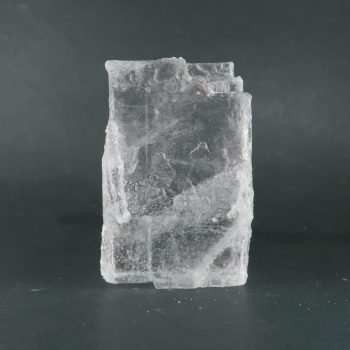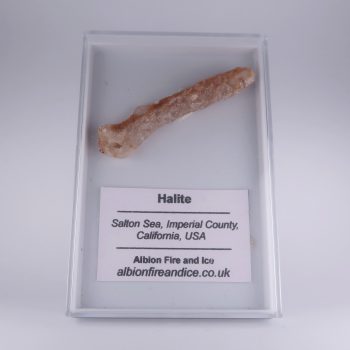Halite
Halite is a crystalline form of sodium hydrochloride, more commonly known as salt.
While its most common usages are for food preparation and in industry, it has recently exploded in popularity as a material for carving; particularly in the forms of salt lamps and tea light holders.
Showing all 2 results
-

Halite from Boulby Mine, North Yorkshire
Price range: £6.00 through £10.00 -

Halite from Salton Sea, USA
£5.00
Appearance, Uses and History
Halite is a large crystalline form of Sodium Chloride, more commonly known as salt. A rock comprised mostly of Halite is known as ‘rock salt’.
One of the most common uses for salt is, simply, in food – it is a preservative and a flavour enhancer. It is also used for agriculture and in various types of industry.
Historically, Salt has been used as a form of currency in various societies. It was also used in warfare to “salt the Earth”, the deliberate sowing of salt to make the enemies ground barren and inhospitable.
It has been used recently for carving; particularly the pink halite known as ‘Himalayan rock salt’, which has been very popular for salt lamps and tea light holders.
Locales
Halite typically occurs as an evaporite deposit around dry lakes and salt beds.
There are considerable deposits in Canada, Pakistan, the UK, and the USA, as well as some interesting specimens from various other countries.
Mineralogy
The most commonly known ‘impure’ colour is a pinky red often referred to as ‘Himalayan rock salt’.
Hazards and Warnings
Almost all rocks, minerals (and, frankly, almost all other substances on earth) can produce toxic dust when cutting, which can cause serious respiratory conditions including silicosis.
When cutting or polishing rocks, minerals, shells, etc, all work should be done wet to minimise the dust, and a suitable respirator or extraction system should be used.
Translations
This material has multiple names; the two most important (and accurate) are ‘rock salt’ and ‘halite’.
Arabic:
- الهاليت
- الملح الصخري
Hindi:
- सेंधा नमक
Portuguese:
- halita
Bengali:
- হ্যালাইট
- খনিজ লবণ
Indonesian:
Punjabi:
English:
- halite
- rock salt
Italian:
- salgemma
Russian:
- галит
- каменная соль
French:
- sel gemme
Japanese:
- 岩塩
Spanish:
- sal de roca
German:
- Halit
- Steinsalz
Korean:
- 암염
Thai:
- เฮไลท์
Gujurati:
Mandarin and Traditional Chinese:
- 岩盐
- 鹽岩
Urdu:
- پتھر نمک
